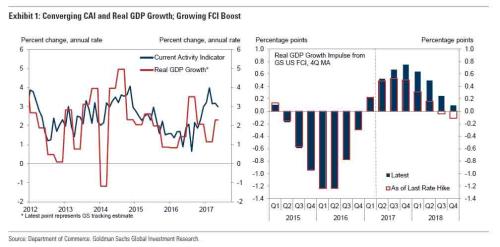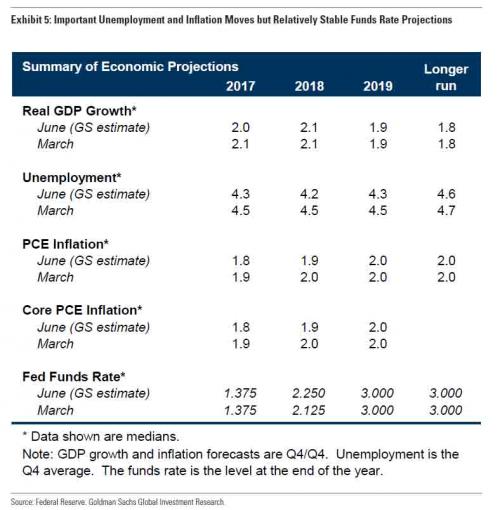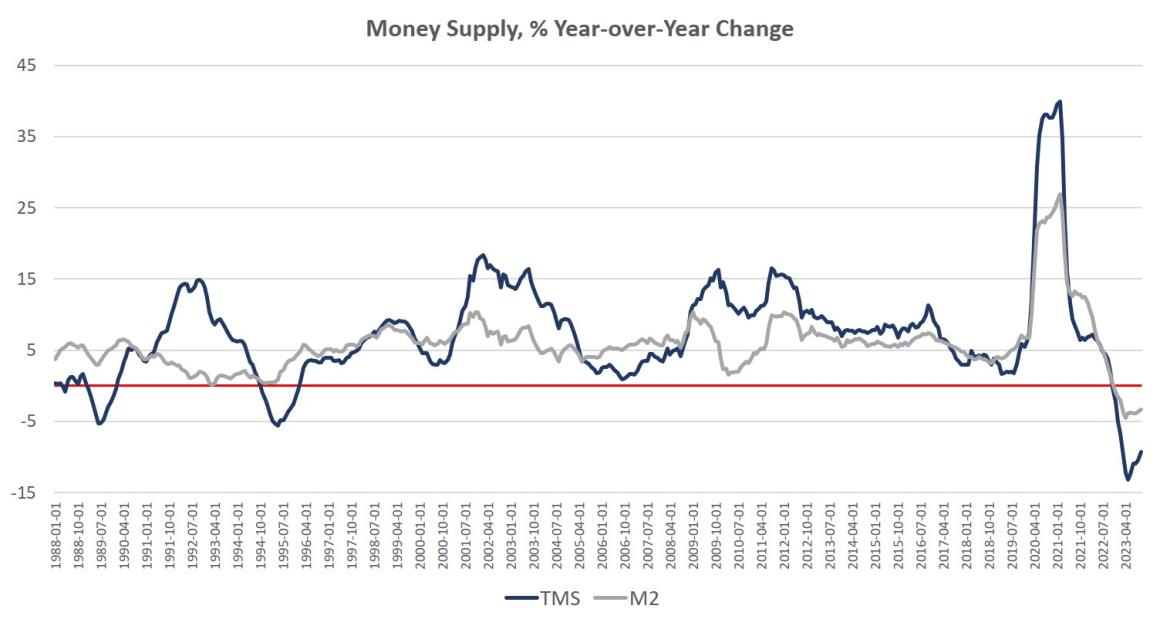On Wedensday the FOMC will hike rates by another 25 bps – an event which the Fed Funds market prices in with near virtual certainty, while Goldman calls the rate increase “extremely likely” – and only a “tail” event like an extremely weak CPI report on Wednesday morning, hours ahead of the Fed announcement, has any chance of preventing this outcome. So with the next rate hike virtually inevitable, questions are focused on not only the Fed’s exit strategy for balance sheet normalization and what the “dots” or funds rate path will look like, but how the Fed squares rising rates with the recent string of inflation misses.
As Goldman’s Jan Hatzius writes, data since the March meeting has sharpened the dilemma that both sides of the mandate are sending increasingly different signals about the urgency of further tightening. “The unemployment rate has fallen 0.4pp since the March meeting and our current activity indicator and real GDP estimates signal that above-trend output growth will produce further labor market improvement. But the year-over-year core PCE inflation is now 0.2pp lower than at the March meeting.”
While conceding that a hike is guaranteed, Goldman notes that two issues should make this meeting particularly interesting.
- First, will Fed officials alter their policy views in response to the increasingly different signals that both sides of the mandate are sending about the urgency of further tightening?
- Second, will the press conference provide some clarity on what the next tightening step following the June hike will be?
As a result of the weaker than expected inflationary prints, Goldman believes the recent data do not call for a major change in the Fed’s policy outlook. While Hatzius expects the FOMC to lower its estimate of the structural unemployment rate by a tenth next week, even with that assumption, the new data have broadly offsetting implications for the policy outlook in standard Taylor rules. Highlighting recent Fed communications, Goldman believes the Fed will follow “a balanced approach in dealing with the dilemma.”
It also means that the statement will likely characterize economic activity as “picking up but recognize that inflation slowed since earlier this year.” On the other side, Goldman sees a signal of heightened inflation concern as the main dovish risk and an upgrade of the balance of risks as the main hawkish risk.
Previewing the Fed’s Summary of Economic Projections (SEP), expect a modest downgrade to GDP growth for this year, coupled with declines in the unemployment rate to 4.3% this year and 4.2% next year. At the same time, projections for core PCE inflation are likely to fall to 1.8% this year and probably 1.9% in 2018. Reflecting the offsetting data news, expect the “dot plot” to show relatively stable funds rate projections.
On to Yellen’s press conference, which should provide some clarity on whether the next tightening step after June will be balance sheet normalization or a third funds rate hike. Goldman, as well as much of the street, expects balance sheet adjustment to start in September and the Fed hiking cycle to resume in December. With respect to the balance sheet, the Fed will initially cap the amounts of securities that can run off in any given month of $10bn for UST and $5 billion for MBS, that rise over four quarters to caps of $40 billion and $20 billion, respectively.
* * *
Some more details. Here is Goldman on the current economic situation, and how it will be (mis)read by the Fed.
Another rate increase from the FOMC next week is now extremely likely. Only an extremely weak CPI report on Wednesday morning or another tail event would prevent the committee from hiking. The committee probably also still expects a total of three hikes and the start of balance sheet adjustment in 2017.
But two issues should make this meeting particularly interesting.
- First, will Fed officials alter their policy views in response to the increasingly different signals that both sides of the mandate are sending about the urgency of further tightening? We expect both lower unemployment and inflation paths in the Summary of Economic Projections (SEP) but relatively stable funds rate projections as the labor market and inflation data surprises, in the words of San Francisco Fed President John Williams, roughly “wash out”.
- Second, will the press conference provide some clarity on what the next tightening step following the June hike will be? We expect a detailed balance sheet announcement in September and a third rate hike in December but the reverse order is also plausible.
We believe both labor market and growth data in hand make a strong case for a rate increase next week and to remain upbeat about the outlook. Both our current activity indicator —down from 4.0% in February to 3.0% in May— and real GDP estimates—up from 1.2% in Q1 to our 2.3% Q2 tracking estimate—signal above-trend output growth (Exhibit 1, left panel). The medium-term growth outlook is also decent despite the lower odds of significant fiscal easing. The more important reason why growth should stay firm is the easing in financial conditions. Our FCI is at the easiest level since early 2015 and has eased by 50bp since the March FOMC meeting. As the right panel of Exhibit 1 shows, the expected effect on GDP growth from changes in financial conditions for 2018H1 is now more than 0.3pp higher than at the March meeting.
Spare capacity continues to diminish, and the unemployment rate has fallen 0.4pp since the March meeting to a 16-year low of 4.3% (Exhibit 2, left panel). While nonfarm payroll growth has recently softened a bit, the average monthly gain of 162k year-to-date is still double our 85k estimate of the “breakeven” rate needed to keep the unemployment rate unchanged. While slack measures have declined more than expected, weak inflation data in April and especially March pushed the year-over-year pace of core PCE inflation 0.2pp lower than at the March Meeting (Exhibit 2, right panel). Both a Taylor rule framework and recent Fed communications suggest that the new data have broadly offsetting implications for the policy outlook.
Exhibit 3 translates the labor market and inflation surprises into changes in the appropriate funds rate via a standard Taylor rule framework. The original Taylor rule implies that a 0.2pp decline in inflation lowers the appropriate funds rate by 30bp while a 0.4pp reduction in the unemployment rate raises the appropriate funds rate by 40bp. In a modified “Taylor 1999” rule, the impact of employment is doubled relative to the original version. This means that the impact of a 0.4pp reduction in unemployment rises from 40bp to 80bp. The left panel of Exhibit 3 thus suggests a 10-50bps higher appropriate funds rate.
But the decline in the unemployment rate may overstate the surprise if some decline was expected. Similarly, the decline in inflation can understate the surprise if some firming was expected. The middle panel of Exhibit 3 therefore compares actual unemployment and inflation moves to our expectations as of the March meeting and has less hawkish implications than the left panel. Finally, a lower estimate of the structural unemployment rate also reduces the decline in the unemployment rate gap. On net, we estimate the new data—combined with a 0.1pp downgrade of the structural rate—would have an exactly neutral effect in the Taylor 1999 rule that Chair Yellen has discussed repeatedly.
What has the Fed communicated in recent week.
Recent Fed communication suggests that the committee will also consider surprises on both sides of the mandate as roughly offsetting. As Exhibit 4 shows, several Fed officials have emphasized that there is now little labor market slack left. The inflation language in the May minutes was quite balanced as ”most participants viewed the recent softer inflation data as primarily reflecting transitory factors, but a few expressed concern that progress toward the Committee’s objective may have slowed.”
Since the May meeting, inflation for April has been weak for core CPI (0.9% annualized) but roughly in line for core PCE (1.8% annualized). The April inflation reports and recent comments by some Fed officials including Chicago Fed President Evans suggest that additional signs of heightened inflation vigilance are a dovish risk relative to our expectations. Governor Powell said that “there are good reasons to expect that inflation will resume its gradual rise but it is important to demonstrate a strong commitment to achieving our symmetric 2 percent objective” while Philadelphia Fed president Harker said that “we’re still on track for inflation” and that he is “looking at the trend.”
In light of these developments we expect to the committee to make three key changes to its post-meeting statement next week. First, we expect the committee to replace “consumer prices declined in March” by “inflation slowed since earlier this year” reflecting the core CPI miss in April. Second, we expect the statement to upgrade the growth assessment with verbiage along the lines of economic activity “appears to have picked up” and to note that household spending “appears to be accelerating”. Third, we expect the committee to tacitly signal balance sheet run-off later this year by adding the qualifier “for the time being” to the description of its existing reinvestment policy.
A signal of heightened inflation concerns is the key dovish risk. The committee may, for instance, drop the “somewhat” from “inflation continued to run somewhat below 2 percent”. In terms of hawkish risks, an upgrade of the balance of risks is possible through the removal of “roughly”, reflecting improved domestic and international growth. We also expect Minneapolis Fed President Neel Kaskhkari to dissent as he recently described the move of inflation in “the wrong direction” as “concerning”.
What about the revised Summary of Economic Projections
The June FOMC meeting will include the quarterly update to the SEP. We expect significant changes to the unemployment and inflation projections but relatively stable funds rate forecasts, reflecting offsetting job market and inflation news.
1. Slightly lower GDP growth: Assuming our Q2 GDP tracking 1. estimate of 2.3%, GDP growth will average 1.7% annualized over the first half of 2017, so it would take a 2.4% growth rate in H2 to meet the policymakers March SEP estimate of 2.1%. We expect the 2017 median to fall to 2.0%, with risk tilted to the upside. We forecast that the median estimates for GDP growth in 2018-2019 and in the longer-run will remain unchanged.
2. Lower unemployment rate. The unemployment rate fell 0.4pp since the March meeting when the median unemployment rate projection was 4.5% for the forecasting horizon. We expect the median to fall to 4.3% in 2017, 4.2% in 2018 (with risks of 4.3%) and 4.3% in 2019. The estimate of the structural unemployment rate is quite likely to fall further from 4.7% to 4.6% in response to large declines in the actual rate and recent news on prices and wages. The decline in NAIRU would limit somewhat the projected employment overshoot but is a close call.
3. Lower core PCE inflation. We expect the 2017 median core PCE projection to fall to 1.8% and perhaps 1.7%. To reach 1.8% by year-end, monthly core PCE inflation would need to accelerate to an annualized rate of at least 1.9%. We believe the 2018 forecast also drops a tenth to 1.9% as some members now likely feel a bit less confident about the inflation outlook.
4. Relatively stable median dots. We expect most participants, especially those in the center of the committee, to stick to their March dots reflecting offsetting inflation and unemployment moves. We also believe that the committee probably still expects a total of three hikes in 2017. The retirement of Tarullo lowers the numbers of participants to 16 from 17 in March and is likely to move up the median 2018 dot from to 3 to 3-1/2 hikes next year. As the FOMC is extremely likely to hike for the second time this year next week, we expect that the 2017 one-hikers will shift to projecting 2 hikes in total for this year. We also assume that the new Atlanta Fed President Bostic votes like his predecessor Lockhart and that the new Richmond Fed President Mullinix lowers the Richmond Fed dots a bit.
Finally, how will the Fed “renornalize” its Balance Sheet.
We expect to get some more clarity next week on balance sheet runoff at the press conference and possibly also with an augmented Policy Normalization Principles and Plan. We continue to look for normalization to be announced in September. Here we update our projections for balance sheet runoff:
1. Start Date: We expect a detailed announcement in September but would not be surprised if it came in December as guidance has been mixed. The May minutes suggest a start in September as an announcement at the December meeting would leave little time to “begin reducing the Federal Reserve’s Securities this year”. But guidance on the start of runoff by Governor Brainard after the funds rate gets midway to its long-run value of 3.0% and by New York Fed President Dudley “sometime later this year or next year” supports December. We think that announcing the start of balance sheet adjustment in September and keeping open the option of foregoing the third 2017 hike is the more prudent course of action given the mixed recent data and the potential for fiscal turmoil in Washington in Q3 related to the need for a debt ceiling hike and an extension of spending authority. We think the detailed announcement in September will be followed by the actual start of runoff of assets in October.
2. Process for phasing out reinvestment: The May minutes signaled that the committee will preannounce a schedule of gradually increasing caps to limit the amounts of securities that can run off in any given month. Our assumption is that that the initial caps are $10 billion a month for UST and $5 billion a month for MBS. The caps would rise each quarter by $10 billion and $5 billion to $40 billion and $20 billion respectively. Exhibit 7 shows that caps allow for a gradual runoff and deal with the variability associated with MBS prepayment and the irregular monthly schedule of maturing assets. The caps will remain in place after the phase-in but then only bind in roughly a third of the months for Treasuries until mid-2020 when the balance sheet reaches its projected terminal size.
3. Terminal size: We expect the Fed to maintain a balance sheet that 3. is relatively large by historical standards given several advantages of a large balance sheet related to monetary policy implementation and regulatory needs. Our calculations suggest that a monetary policy implementation through a floor system implies a terminal size of roughly 15.5% of GDP. While support from the New York Fed for the large balance scenario makes this outcome quite likely, there is no urgency yet in deciding on the size and on the composition of the terminal balance sheet.
Goldman’s conclusion:
A third consecutive quarterly rate increase next week is now extremely likely, in our view. Only an extremely weak CPI report on Wednesday morning or another tail event would prevent the committee from hiking. The data news since March has sharpened the dual mandate dilemma policymakers are facing. Our own view is that the inflation and unemployment surprises have been roughly offsetting but that the range of outcomes has widened somewhat. While the inflation outlook is uncertain, the dilemma will most likely resolve itself as inflation gradually accelerates. We therefore expect policymakers to remain focused on tightening mostly with the funds rate but also soon with the balance sheet tool.
And while we agree with Goldman in theory, one thing the bank has omitted in principle is that according to the Fed’s own commercial loan data, the US economy may be just 4-6 weeks away from posting its first negative C&I loan print since the financial crisis: a virtually failsafe indication of an imminent (or concurrent) recession.

Which means that, as we explained yesterday, the Fed is about to hike in not only a disinflationary phase of the economic cycle (which is largely a function of the slowdown in the Chinese commoity bubble, and the collapse in the Chinese credit impulse), but also into what may be an outright recession in the US. If so, look for the yield curve to do what it has always done in the past after the Fed hikes rates: flatten, then flatten some more, than go horizontal, and eventually invert.










